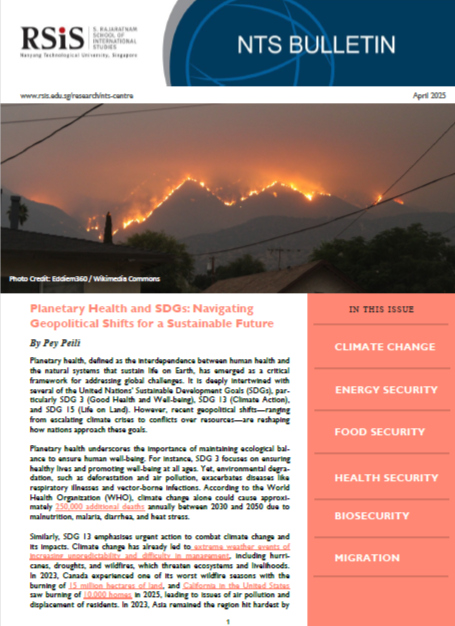23 April 2025
- RSIS
- Publication
- RSIS Publications
- NTS Bulletin April 2025
Planetary health, defined as the interdependence between human health and the natural systems that sustain life on Earth, has emerged as a critical framework for addressing global challenges. It is deeply intertwined with several of the United Nations’ Sustainable Development Goals (SDGs), particularly SDG 3 (Good Health and Well-being), SDG 13 (Climate Action), and SDG 15 (Life on Land). However, recent geopolitical shifts—ranging from escalating climate crises to conflicts over resources—are reshaping how nations approach these goals.
Planetary health underscores the importance of maintaining ecological balance to ensure human well-being. For instance, SDG 3 focuses on ensuring healthy lives and promoting well-being at all ages. Yet, environmental degradation, such as deforestation and air pollution, exacerbates diseases like respiratory illnesses and vector-borne infections. According to the World Health Organization (WHO), climate change alone could cause approximately 250,000 additional deaths annually between 2030 and 2050 due to malnutrition, malaria, diarrhea, and heat stress.
Similarly, SDG 13 emphasises urgent action to combat climate change and its impacts. Climate change has already led to extreme weather events of increasing unpredictability and difficulty in management, including hurricanes, droughts, and wildfires, which threaten ecosystems and livelihoods. In 2023, Canada experienced one of its worst wildfire seasons with the burning of 15 million hectares of land, and California in the United States saw burning of 10,000 homes in 2025, leading to issues of air pollution and displacement of residents. In 2023, Asia remained the region hit hardest by extreme weather events with more than 2000 recorded fatalities and nine million people directly impacted by floods and storms. Such events highlight the inter-connectedness of planetary health, climate stability, and the security, safety, and wellbeing of human lives.
SDG 15 aims to protect, restore, and promote sustainable use of terrestrial ecosystems. Deforestation rates remain alarmingly high, driven by agricultural expansion and illegal logging. The Amazon rainforest, often referred to as the “lungs of the planet,” lost an area equivalent to seven times the size of London in just one year, according to satellite data analysed by Brazil’s National Institute for Space Research (INPE).
Recent geopolitical changes add complexity to achieving these SDGs. One significant development is the growing competition for critical minerals essential for renewable energy technologies, such as lithium and cobalt. As countries transition away from fossil fuels, demand for these resources has surged, leading to disputes over mining rights and supply chain dominance. For example, tensions between China and Western nations over rare earth elements underscore the need for equitable resource management. These developments directly impact the progress on SDG 13 and mismanagement of mining activities could exacerbate degradation of SDG 3 and SDG 15.
To accelerate progress toward the SDGs amid these challenges, stakeholders must adopt innovative strategies:
- Invest in Circular Economies: Transitioning to circular economies—where waste is minimised, and materials are reused—can reduce the region’s existing re-source dependencies. Circular economies supported by bilateral and multilateral collaborative efforts can be scaled up to counter global fragmentation and facilitate shared responsibility.
- Enhance Local Resilience: Communities vulnerable to climate impacts particularly in Asia and ASEAN require support to build resilience. This includes national and regional investing in early warning systems, climate-smart agriculture, disaster preparedness infrastructure, and community engagement in policymaking.
- Promote Equitable Financing Mechanisms: Wealthier nations must fulfill their commitment to provide climate finance to developing countries and especially those in Asia and ASEAN disproportionately vulnerable to climate shocks. Innovative funding models, such as green bonds and carbon pricing, can also mobilise private sector investment.
Planetary health serves as a unifying lens through which we can address the SDGs amidst evolving geopolitical landscapes. By strengthening international collaboration, embracing sustainable practices, and empowering local communities, stakeholders can overcome barriers to achieving these goals. The window of opportunity is narrowing, but concerted efforts can still secure a healthier and more intergenerationally equitable future.
Planetary health, defined as the interdependence between human health and the natural systems that sustain life on Earth, has emerged as a critical framework for addressing global challenges. It is deeply intertwined with several of the United Nations’ Sustainable Development Goals (SDGs), particularly SDG 3 (Good Health and Well-being), SDG 13 (Climate Action), and SDG 15 (Life on Land). However, recent geopolitical shifts—ranging from escalating climate crises to conflicts over resources—are reshaping how nations approach these goals.
Planetary health underscores the importance of maintaining ecological balance to ensure human well-being. For instance, SDG 3 focuses on ensuring healthy lives and promoting well-being at all ages. Yet, environmental degradation, such as deforestation and air pollution, exacerbates diseases like respiratory illnesses and vector-borne infections. According to the World Health Organization (WHO), climate change alone could cause approximately 250,000 additional deaths annually between 2030 and 2050 due to malnutrition, malaria, diarrhea, and heat stress.
Similarly, SDG 13 emphasises urgent action to combat climate change and its impacts. Climate change has already led to extreme weather events of increasing unpredictability and difficulty in management, including hurricanes, droughts, and wildfires, which threaten ecosystems and livelihoods. In 2023, Canada experienced one of its worst wildfire seasons with the burning of 15 million hectares of land, and California in the United States saw burning of 10,000 homes in 2025, leading to issues of air pollution and displacement of residents. In 2023, Asia remained the region hit hardest by extreme weather events with more than 2000 recorded fatalities and nine million people directly impacted by floods and storms. Such events highlight the inter-connectedness of planetary health, climate stability, and the security, safety, and wellbeing of human lives.
SDG 15 aims to protect, restore, and promote sustainable use of terrestrial ecosystems. Deforestation rates remain alarmingly high, driven by agricultural expansion and illegal logging. The Amazon rainforest, often referred to as the “lungs of the planet,” lost an area equivalent to seven times the size of London in just one year, according to satellite data analysed by Brazil’s National Institute for Space Research (INPE).
Recent geopolitical changes add complexity to achieving these SDGs. One significant development is the growing competition for critical minerals essential for renewable energy technologies, such as lithium and cobalt. As countries transition away from fossil fuels, demand for these resources has surged, leading to disputes over mining rights and supply chain dominance. For example, tensions between China and Western nations over rare earth elements underscore the need for equitable resource management. These developments directly impact the progress on SDG 13 and mismanagement of mining activities could exacerbate degradation of SDG 3 and SDG 15.
To accelerate progress toward the SDGs amid these challenges, stakeholders must adopt innovative strategies:
- Invest in Circular Economies: Transitioning to circular economies—where waste is minimised, and materials are reused—can reduce the region’s existing re-source dependencies. Circular economies supported by bilateral and multilateral collaborative efforts can be scaled up to counter global fragmentation and facilitate shared responsibility.
- Enhance Local Resilience: Communities vulnerable to climate impacts particularly in Asia and ASEAN require support to build resilience. This includes national and regional investing in early warning systems, climate-smart agriculture, disaster preparedness infrastructure, and community engagement in policymaking.
- Promote Equitable Financing Mechanisms: Wealthier nations must fulfill their commitment to provide climate finance to developing countries and especially those in Asia and ASEAN disproportionately vulnerable to climate shocks. Innovative funding models, such as green bonds and carbon pricing, can also mobilise private sector investment.
Planetary health serves as a unifying lens through which we can address the SDGs amidst evolving geopolitical landscapes. By strengthening international collaboration, embracing sustainable practices, and empowering local communities, stakeholders can overcome barriers to achieving these goals. The window of opportunity is narrowing, but concerted efforts can still secure a healthier and more intergenerationally equitable future.





